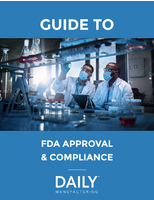Subcommittee approves biocide release rate standard.
Press Release Summary:
Developed by Subcommittee D01.45 on Marine Coatings, D 6903 standard can be used by manufacturers of preservatives and antifouling paints to evaluate quality of products by comparing biocide leach rates in one formulation against another product. Standard is based on ASTM methods developed to quantify tin and copper release rates. Test Method D 6903 is run entirely in laboratory under controlled conditions of pH, temperature, salinity, and hydrodynamics.
Original Press Release:
ASTM Marine Coatings Subcommittee Approves New Biocide Release Rate Standard
Manufacturers of preservatives and antifouling paints will be able to use a new ASTM International standard to evaluate the quality of their products by comparing biocide leach rates in one formulation against a competitive product or their own products. The new standard, D 6903, Test Method for Determination of Organic Biocide Release Rate from Antifouling Coatings in Substitute Ocean Water, was developed by Subcommittee D01.45 on Marine Coatings, which is part of ASTM International Committee D01 on Paint and Related Coatings, Materials and Applications.
According to Deepak Doshi, chair of the task group that developed D 6903 and group leader of the biocides research analytical group of the process chemicals and biocides department at Rohm and Haas, the two most widely used biocides in antifouling coatings, tributyl tin (TBT) and cuprous oxide, face increasing environmental restrictions. For example, the use of the biocide TBT has been almost entirely banned as a result of the IMO (International Maritime Organization) TBT convention (The International Convention on the Control of Harmful Antifouling Systems on Ships, adopted in 2001) due to its persistence in seawater and the use of cuprous oxide being limited in certain geographical locations.
The use of rapidly biodegradable alternatives to tin and copper is increasing. Therefore, Committee D01 saw a need to develop a release rate method to quantify their release and has recently approved D 6903, which covers the laboratory determination of the rate at which organic biocides are released from an antifouling coating exposed in substitute ocean water.
Test Method D 6903 is run entirely in the laboratory under controlled conditions of pH, temperature, salinity and hydrodynamics. D 6903 is based on the ASTM methods developed to quantify tin and copper release rates (D 5108, Test Method for Organotin Release Rates of Antifouling Coating Systems in Sea Water, and D 6442, Test Method for Determination of Copper Release Rate from Antifouling Coatings in Substitute Ocean Water). Similar methods are being developed by the International Organization for Standardization (ISO TC35/SC9/WG27) for biocides not registered for use in the United States. Committee D01 and ISO are working together to harmonize these methods and to avoid duplication of effort.
Doshi says that interested parties are invited to join Subcommittee D01.45 in its standards developing activities. "More participation is always welcome as diverse views and opinions make the standard that much more valid and robust," says Doshi. The subcommittee would especially like to see participation from regulatory agencies such as the U.S. Environmental Protection Agency, Canadian and state government agencies and academia.
ASTM International standards are available for purchase from Customer Service (phone: 610/832-9585; service@astm.org) or at www.astm.org. For further technical information, contact Deepak Doshi, Rohm and Haas Company, Spring House, Pa. (phone: 215/641-7441; ddoshi@rohmhaas.com). Committee D01 meets Jan. 20-22, 2008, at January Committee Week in Ft. Lauderdale, Fla. For membership or meeting information, contact Jeffrey Adkins, Technical Committee Operations, ASTM International (phone: 610/832-9738; jadkins@astm.org).




